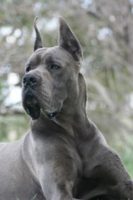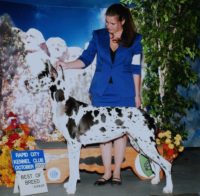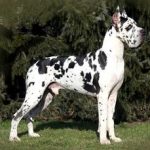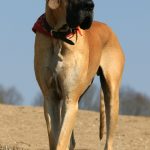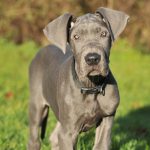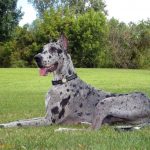 The Great Dane is one of the largest breeds of dog. It’s a German breed that’s known for being gigantic. Zeus was the largest ever Great Dane on record being and died in September of 2014. Zeus measured 111.8cm from the bottom of his paw to the top of his shoulder.
The Great Dane is one of the largest breeds of dog. It’s a German breed that’s known for being gigantic. Zeus was the largest ever Great Dane on record being and died in September of 2014. Zeus measured 111.8cm from the bottom of his paw to the top of his shoulder.
Great Dane History
Some people believe that the Great Dane, or at least an ancestor for the breed, goes back to 1121 BC. Chinese literature goes way back to this time, with reports of dogs being described that share characteristics of the dog breed.
It is thought that the Great Dane was later taken from China by the Assyrians who began trading the dogs with Romans and Greeks. The Romans and Greeks then went about breeding the dogs with other breeds. It is thought that the English Mastiff was used to breed the modern Great Dane, along with large dogs like the Irish Greyhound and Wolfhound.
Boar and Bear Hunting
Originally Great Danes were named Boar Hounds given that they were bred to hunt bears and boars. The breed had small ears that didn’t get in the way of boar tusks. During the 1600s German nobles began taking the biggest examples of the Great Dane into their homes, calling them Chamber Dogs. The nobles lived with them as pets and the dogs were treated to a life of luxury. It was only in the next century that the Great Dane got its new name.
After seeing a Boar Hound as they were then called, which appeared slimmer and more like a greyhound, a French traveller in Denmark took the dog and called it Grand Danois – which translated to ‘Great Danish Dog’. He bred the dog with large Danish Mastiffs, and so the Great Dane was born. Breed historians give more credit to German dog breeders in the 1800’s for creating a dog that looks most like the modern Great Dane.
Rich German dog breeders kept on refining the breed during the 1800’s. The breeders reduced the aggressive temperament that was originally bred into the dogs for fighting, and replaced it with a gentler attitude suitable for companion dogs. Nobody has been really been certain when the Great Dane first crossed the Atlantic after the Germans refined the breed. Breeders founding the Great Dane Club of America in 1889. It was the fourth club that join the American Kennel Club. The dog already has a long history on this side of the Atlantic.
Good Natured and Friendly
After successfully breeding in a new temperament in the 1800s, the Germans created a Great Dane that loves its companion and is exceptionally friendly. Good natured and friendly, the Great Dane is great with children. This breed is always eager to please his or her owners.
If you have a big family, your Great Dane will love it. They’re surprisingly good with children despite their size. They do forget their size at times, meaning they’ll try and sit on your lap and may knock over furniture without thinking about it.
Too ensure a Great Dane grows up to be happy and friendly, it’s important to take them to classes as puppies. Mingling with other people dogs is a great way to ensure that the best of your dog’s personality comes out in their later years. This is important as the breed can be quite protective of its owners and family.
Great Dane Health Problems
Being such a large dog, Great Danes can be susceptible to some growth problems. Particularly, puppies can experience development issues. Hip dysplasia is also not uncommon. This is an inherited condition whereby the thighbone doesn’t properly fit into the hip joint. This means the leg can become disjointed and painful. A Great Dane with this condition might show signs of pain in one or two of its back legs. Veterinarians can screen for this with X-rays from a young age.
Great Danes can be prone to arthritis as they get older. Feed your dog a healthy diet to help reduce the risk and effects of arthritis. Including plenty of healthy oils and fats in their diets is particularly helpful.
